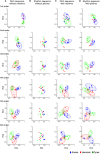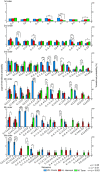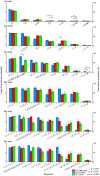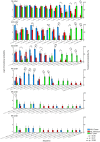Musical Creativity and Depth of Implicit Knowledge: Spectral and Temporal Individualities in Improvisation
- PMID: 30483087
- PMCID: PMC6243102
- DOI: 10.3389/fncom.2018.00089
Musical Creativity and Depth of Implicit Knowledge: Spectral and Temporal Individualities in Improvisation
Abstract
It has been suggested that musical creativity is mainly formed by implicit knowledge. However, the types of spectro-temporal features and depth of the implicit knowledge forming individualities of improvisation are unknown. This study, using various-order Markov models on implicit statistical learning, investigated spectro-temporal statistics among musicians. The results suggested that lower-order models on implicit knowledge represented general characteristics shared among musicians, whereas higher-order models detected specific characteristics unique to each musician. Second, individuality may essentially be formed by pitch but not rhythm, whereas the rhythms may allow the individuality of pitches to strengthen. Third, time-course variation of musical creativity formed by implicit knowledge and uncertainty (i.e., entropy) may occur in a musician's lifetime. Individuality of improvisational creativity may be formed by deeper but not superficial implicit knowledge of pitches, and that the rhythms may allow the individuality of pitches to strengthen. Individualities of the creativity may shift over a musician's lifetime via experience and training.
Keywords: Implicit learning; Markov model; characteristics; entropy; hierarchy; n-gram; statistical learning; uncertainty.
Figures






Similar articles
-
Entropy, Uncertainty, and the Depth of Implicit Knowledge on Musical Creativity: Computational Study of Improvisation in Melody and Rhythm.Front Comput Neurosci. 2018 Dec 19;12:97. doi: 10.3389/fncom.2018.00097. eCollection 2018. Front Comput Neurosci. 2018. PMID: 30618691 Free PMC article.
-
Statistical Properties of Musical Creativity: Roles of Hierarchy and Uncertainty in Statistical Learning.Front Neurosci. 2021 Apr 20;15:640412. doi: 10.3389/fnins.2021.640412. eCollection 2021. Front Neurosci. 2021. PMID: 33958983 Free PMC article. Review.
-
Temporal dynamics of uncertainty and prediction error in musical improvisation across different periods.Sci Rep. 2024 Sep 27;14(1):22297. doi: 10.1038/s41598-024-73689-x. Sci Rep. 2024. PMID: 39333792 Free PMC article.
-
Resting-state basal ganglia network codes a motor musical skill and its disruption From dystonia.Mov Disord. 2018 Sep;33(9):1472-1480. doi: 10.1002/mds.27448. Epub 2018 Sep 15. Mov Disord. 2018. PMID: 30277603 Free PMC article.
-
Rapid and flexible creativity in musical improvisation: review and a model.Ann N Y Acad Sci. 2018 Mar 25. doi: 10.1111/nyas.13628. Online ahead of print. Ann N Y Acad Sci. 2018. PMID: 29577331 Review.
Cited by
-
Concurrent Statistical Learning of Ignored and Attended Sound Sequences: An MEG Study.Front Hum Neurosci. 2019 Apr 17;13:102. doi: 10.3389/fnhum.2019.00102. eCollection 2019. Front Hum Neurosci. 2019. PMID: 31057378 Free PMC article.
-
Temporal dynamics of statistical learning in children's song contributes to phase entrainment and production of novel information in multiple cultures.Sci Rep. 2023 Oct 23;13(1):18041. doi: 10.1038/s41598-023-45493-6. Sci Rep. 2023. PMID: 37872404 Free PMC article.
-
Entropy, Uncertainty, and the Depth of Implicit Knowledge on Musical Creativity: Computational Study of Improvisation in Melody and Rhythm.Front Comput Neurosci. 2018 Dec 19;12:97. doi: 10.3389/fncom.2018.00097. eCollection 2018. Front Comput Neurosci. 2018. PMID: 30618691 Free PMC article.
-
Statistical Properties of Musical Creativity: Roles of Hierarchy and Uncertainty in Statistical Learning.Front Neurosci. 2021 Apr 20;15:640412. doi: 10.3389/fnins.2021.640412. eCollection 2021. Front Neurosci. 2021. PMID: 33958983 Free PMC article. Review.
-
Tonality Tunes the Statistical Characteristics in Music: Computational Approaches on Statistical Learning.Front Comput Neurosci. 2019 Oct 2;13:70. doi: 10.3389/fncom.2019.00070. eCollection 2019. Front Comput Neurosci. 2019. PMID: 31632260 Free PMC article.
References
-
- Albrecht J., Huron D. (2012). A statistical approach to tracing the historical development of major and minor pitch distributions, 1400-1750. Music Percept. 31, 223–243. 10.1525/mp.2014.31.3.223 - DOI
-
- Albrecht J., Shanahan D. (2013). The use of large corpora to train a new type of key-finding algorithm: an improved treatment of the minor mode. Music Percept. 31, 59–67. 10.1525/mp.2013.31.1.59 - DOI
-
- Applebaum D. (2008). Probability and Information: An Integrated Approach. Cambridge, UK: Cambridge University Press.
-
- Backer E., van Kranenburg P. (2005). On musical stylometry—a pattern recognition approach. Pattern Recogn. Lett. 26, 299–309. 10.1016/j.patrec.2004.10.016 - DOI
LinkOut - more resources
Full Text Sources

